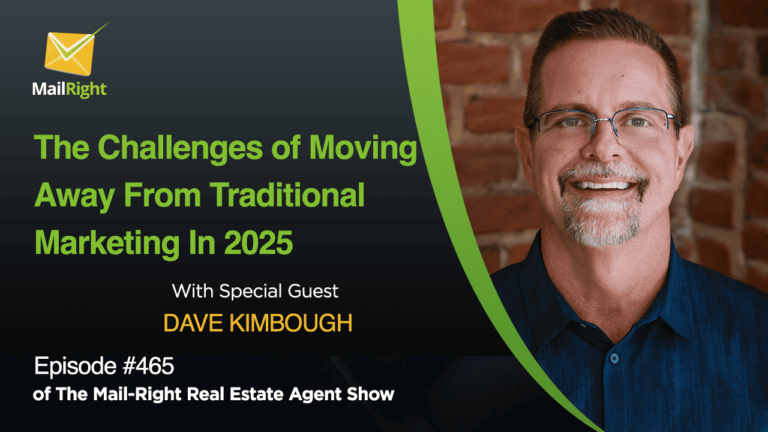In episode 469 of the Mail Right Show, Robert Newman and Jonathan Denwood shared valuable insights about content marketing strategies for real estate agents. The discussion covered everything from building a sustainable strategy to create trust and engagement to agents’ common mistakes and how to fix them. Robert Newman is the founder of Inbound REM, an inbound marketing firm focusing on real estate and SEO. Meanwhile, Jonathan Denwood is the joint-founder of Mail-Right, a CRM lead generative platform providing a great website solution.
How to Build Your Real Estate Content Marketing Strategy?
Creating an effective content marketing strategy begins with identifying topics you’re genuinely passionate about. Many agents make the mistake of choosing subjects they think will attract clients rather than what they truly care about. For example, one agent had extensive knowledge about mid-century modern homes but avoided creating content about them because these properties weren’t the most expensive in his market. His true enthusiasm made his content far more engaging and effective when he finally started focusing on this niche. The key lesson here is that passion translates into better content.
Before planning your strategy, ask yourself: What aspects of real estate genuinely excite me? What could I talk about for hours? These are likely your best content topics; quality content combined with genuine passion creates the most effective approach.
Tips for Creating a Killer Real Estate Content Marketing Strategy
Creating high-performing content requires careful research and planning. If you’re a real estate agent working in a local market, focusing on hyperlocal strategies can still be incredibly effective, especially when combined with your website content and social media presence. By consistently showcasing your expertise in the local area, you can successfully compete with larger platforms like Zillow, Realtor.com, and major brokerages. However, to see real results, it’s crucial to have a clear plan of action. Posting content only when you have spare time isn’t enough; a consistent, strategic approach is key to standing out in a crowded digital space.
Several practical tools can help you identify what potential clients are searching for online.
VidIQ helps analyze YouTube search patterns, Ubersuggest provides keyword ideas, and Google Trends shows current popular topics. For instance, if you’re creating content about Zillow, these tools can reveal related questions people are asking, such as “Is Zillow accurate?” or “What are Zillow alternatives?”
Remember to treat every keyword as a specific question that needs answering. When someone searches for “homes for sale in Tacoma,” your content should directly address that query with clear, helpful information. There’s also a “skyscraper technique” where you find existing high-performing content and make it even better by adding more value through videos, podcasts, or deeper analysis.
Content marketing requires patience and consistency. While it doesn’t produce overnight results, a well-executed strategy builds lasting credibility and trust.
Finding the Smaller Wins Within the Larger Goal
Content marketing is a long-term game, and waiting for immediate results can be discouraging. Focus on smaller, measurable successes to stay motivated. Two key metrics to track are visibility— are your chosen keywords ranking in search results— and engagement — how are people interacting with your content?.
For video content, pay special attention to “minutes watched” rather than just view counts, as this shows genuine interest. Appreciate positive engagement metrics long before receiving client calls, as it will help you stay motivated during the months it often takes for content marketing to yield direct business results. Remember that in challenging markets, consistent content creation can help agents stand out when competitors are scaling back their efforts.
Appeal to All Stages of the Buying Process
Many agents focus solely on clients who are ready to buy or sell immediately, missing opportunities with people at other stages of the real estate cycle. The average homeowner moves every 10 years, meaning your content should address different needs throughout this cycle.
Content about home improvements and maintenance works well for new homeowners. Market updates and equity-building tips are valuable for those in the middle of their ownership period. As homeowners approach selling age, content about maximizing property value becomes relevant. You can share neighborhood event information or host casual gatherings to stay connected with the client throughout this long time.
Tracking All Stages of the Lead Lifecycle Accurately
Many agents fall short of properly tracking leads. To do it right, there are two approaches. First, you may use a platform, like InboundRem system, where leads receive no follow-up beyond being added to a high-value newsletter list. Second, have an active relationship management. Regardless of your approach, simplicity is still the key; trying to track too many metrics often leads to frustration. Focus on 2-3 meaningful indicators rather than getting overwhelmed with data.
For email lists, create substantial, well-researched content like detailed case studies rather than frequent promotional messages. An annual check-in, like “would you like to chat again?” can be a nonintrusive way to reconnect. Local community involvement is crucial, not as a direct sales tactic but as a way to naturally maintain relationships over time.





